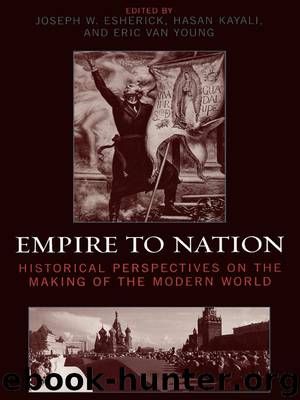Empire to Nation by Unknown

Author:Unknown
Language: eng
Format: epub
ISBN: 9780742578159
Publisher: Rowman & Littlefield Publishers
Published: 2013-07-10T16:00:00+00:00
Reforming the Empire
The road from the Ottoman imperial kaleidoscope to the rigidly defined world of the successor nation-states was a long one. The first part of this process goes back to the end of the seventeenth century when the imperial state undertook a multifaceted program of registering, settling, and conscripting the very large number of nomadic tribes that were among its taxpaying subjects. While it was implemented only partially, and was motivated by the military concerns of the state, this was nevertheless a first step toward creating more sedentary, and hence more easily taxed and administered, subjects for the Ottoman state. This was also the first step in transforming the imperial institutions into ones that were better equipped to define and apply uniform and centralized methods of overrule.18
In the eighteenth and nineteenth centuries, the Ottomans continued with more ambitious projects that aimed to reform the empire’s legal, administrative, educational, and military institutions, and also adopted explicit rules that recognized the rights and exemptions of non-Muslim subjects.19 These institutional reforms were reinforced by further initiatives that sought to cultivate a sense of Ottomanness that would cut across the various religious communities. For example, non-Muslims were no longer required to convert before they could enroll in military schools and serve in the Ottoman army. This created an important institutional context where people of different faiths could be trained to serve and even fight for the Ottoman state. Non-Muslims also became eligible to be appointed to some of the highest posts in the government without having to change their religion. Starting as early as 1845, a succession of representative assemblies and other elected bodies were convened to help govern the empire. Non-Muslims were part of these experiments as well. The Ottomans also tried to come up with a clearer definition of nationality and citizenship, which culminated in the drafting of the new Law on Nationality in 1869. According to this law, all persons who lived in the Ottoman Empire were considered Ottoman subjects unless they could prove otherwise. The same law also regulated the issuing and control of passports.20 Ultimately, in a constitution that was adopted in 1876, the Ottoman government entered, for the first time, into a contractual relationship with various religious groups about the mechanisms of lawmaking and representation in the Ottoman Empire.
Even though they appeared to be well thought out and comprehensive, the reforms of the nineteenth century nevertheless contained a fundamental weakness. In particular, the way in which the idea of Ottomanism was articulated and promoted was not based on a thorough and serious study of who the subject people of the empire were, what their interests might be, or how they could be brought together to serve the broader interests of the imperial state. It seems that Ottoman officials expected that a sense of Ottomanism would develop by itself if people of different ethnic and religious backgrounds were provided with space and opportunity to interact and cooperate with each other. Beyond this, the questions of how the people
Download
This site does not store any files on its server. We only index and link to content provided by other sites. Please contact the content providers to delete copyright contents if any and email us, we'll remove relevant links or contents immediately.
The Art of Boudoir Photography: How to Create Stunning Photographs of Women by Christa Meola(18583)
Red Sparrow by Jason Matthews(5429)
Harry Potter 02 & The Chamber Of Secrets (Illustrated) by J.K. Rowling(3647)
In a Sunburned Country by Bill Bryson(3509)
Drawing Cutting Edge Anatomy by Christopher Hart(3489)
Figure Drawing for Artists by Steve Huston(3412)
Harry Potter and the Prisoner of Azkaban (Book 3) by J. K. Rowling(3325)
The Daily Stoic by Holiday Ryan & Hanselman Stephen(3268)
Japanese Design by Patricia J. Graham(3139)
The Roots of Romanticism (Second Edition) by Berlin Isaiah Hardy Henry Gray John(2888)
Make Comics Like the Pros by Greg Pak(2883)
Stacked Decks by The Rotenberg Collection(2846)
Draw-A-Saurus by James Silvani(2690)
Harry Potter and the Deathly Hallows (7) by J.K. Rowling(2682)
Tattoo Art by Doralba Picerno(2627)
On Photography by Susan Sontag(2608)
Churchill by Paul Johnson(2544)
The Daily Stoic by Ryan Holiday & Stephen Hanselman(2532)
Drawing and Painting Birds by Tim Wootton(2475)
